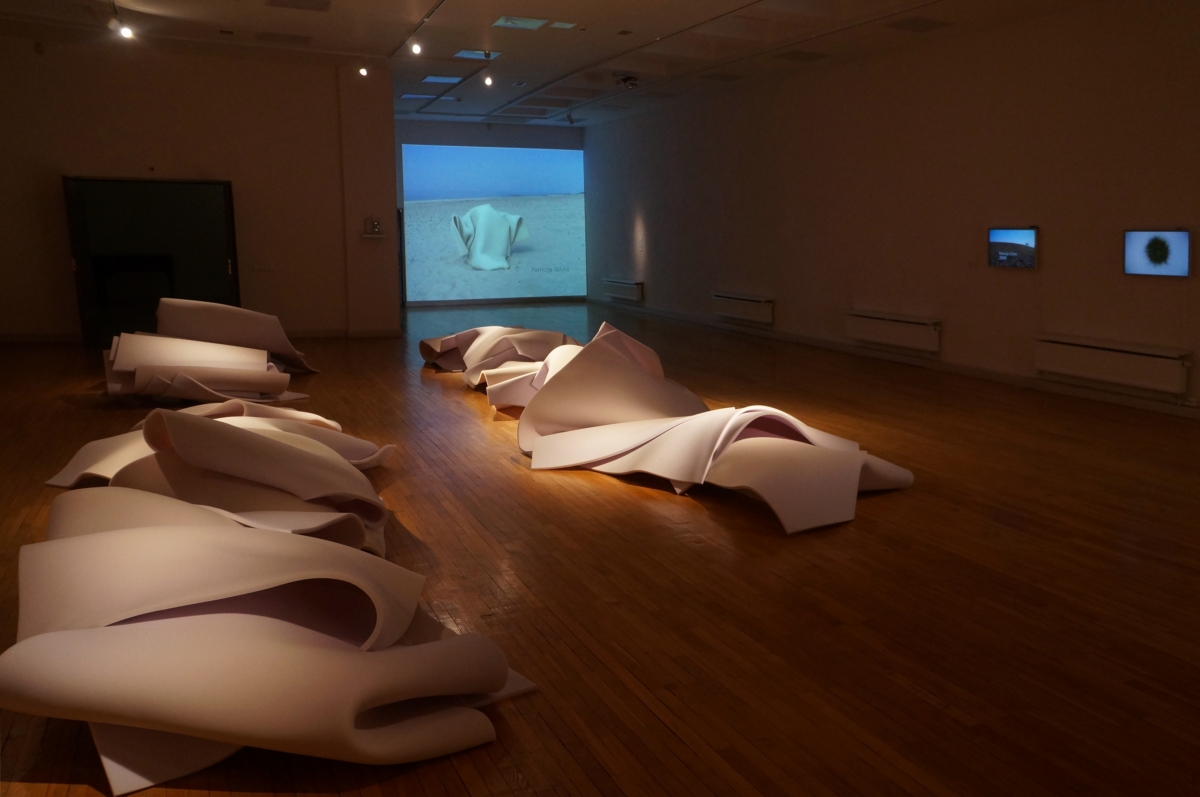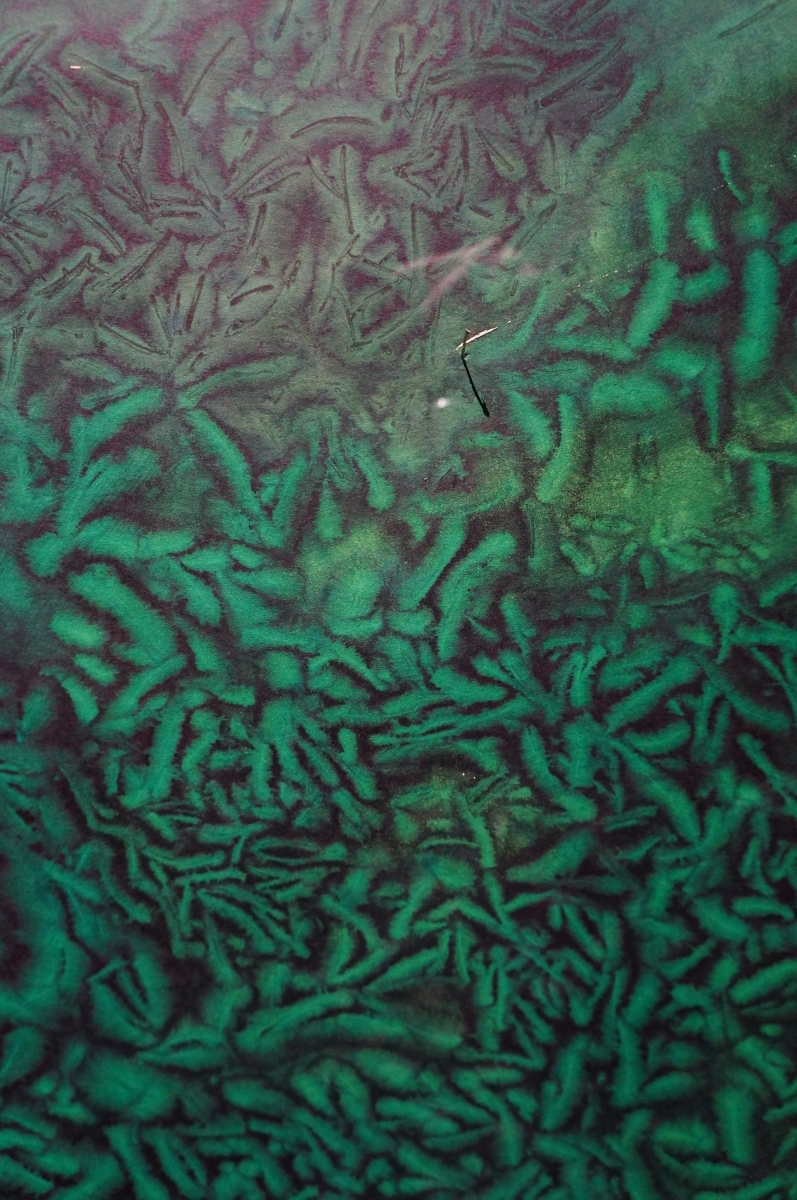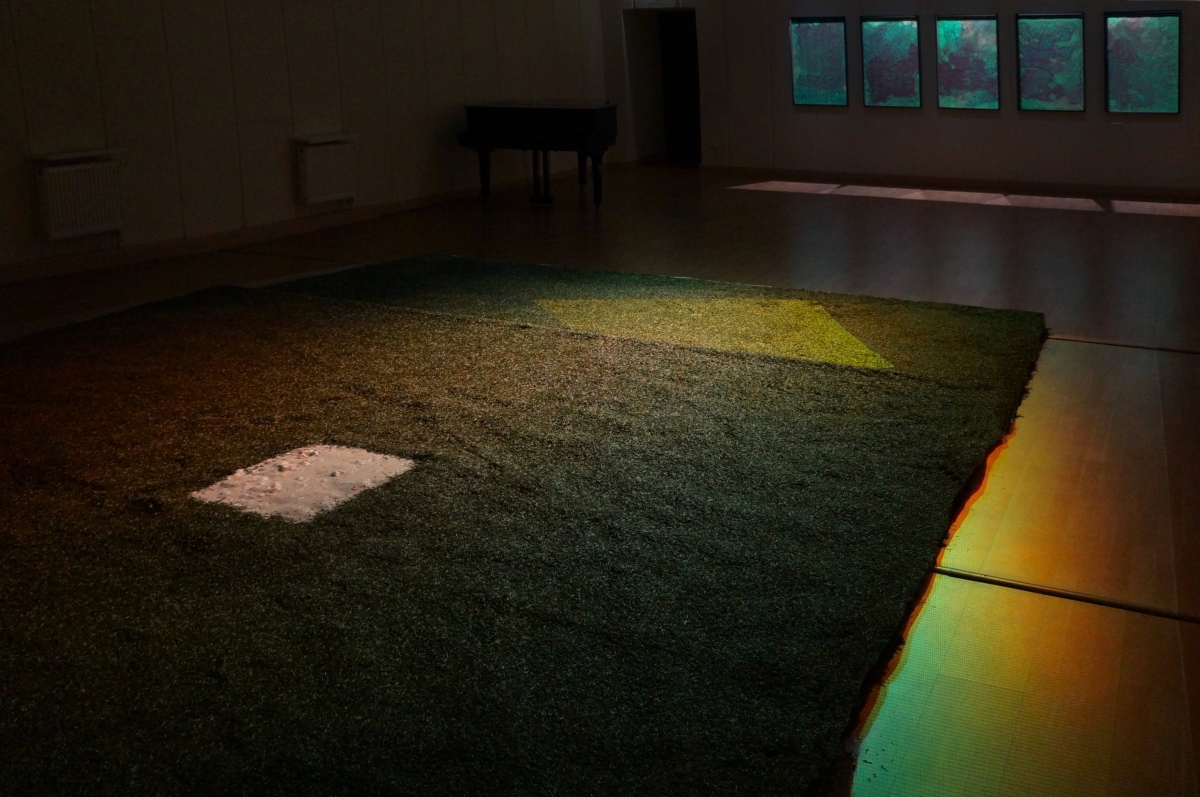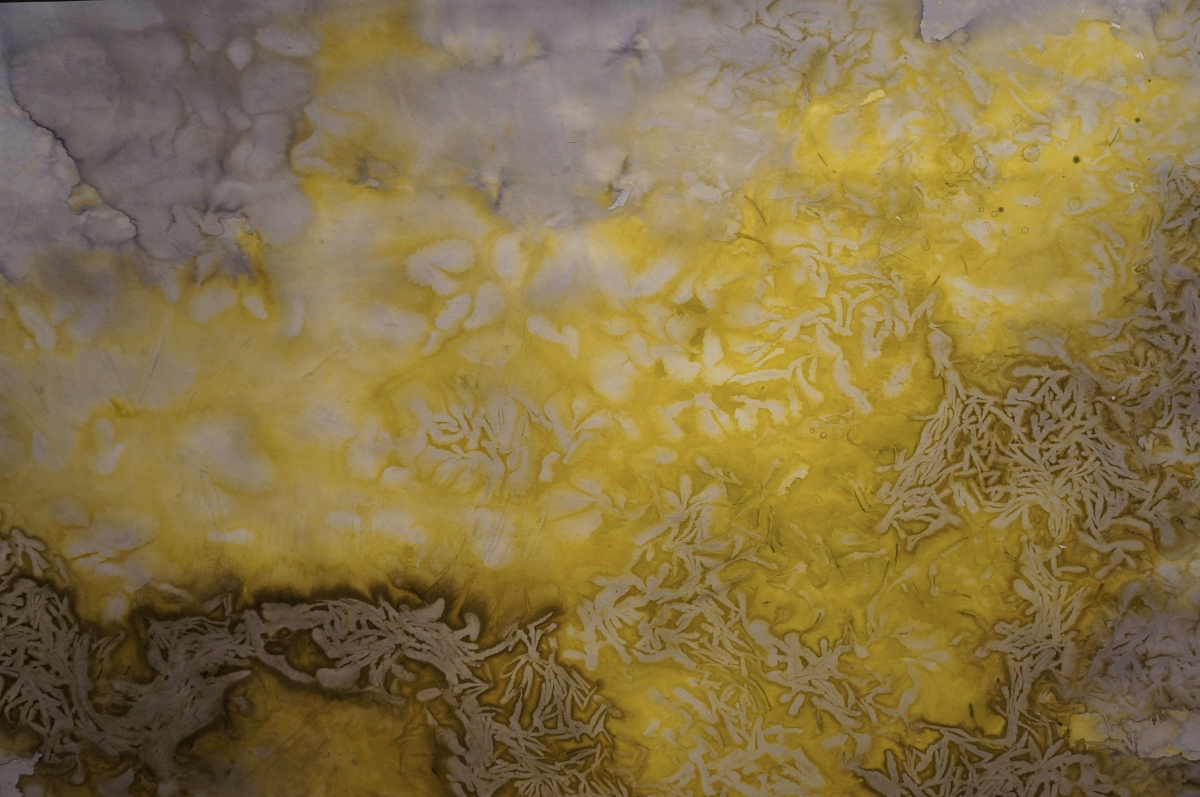No one disputes that humans are territorial animals. We are constantly expanding our territory, fighting for resources, and even in our environmental initiatives we can catch a glimpse of the arrogant and predatory human nature: it’s always ‘the other’ who is threatening the earth with pollution, climate change and overpopulation, leaving ‘us’ with scarce possibilities of survival, unless we act and take the land, both physically and metaphorically. Sometimes even the artist’s creative practice includes assuming control over display spaces. Like a prehistoric hunter-gatherer, the artist enters a new territory with an evolutionary imperative telling them to claim the ‘wilderness’ of the exhibition ground. However, this impulse should not be understood as a belligerent act: we are all operating within an adaptive framework.
A good example of such a creative strategy in an artist’s work is the case of Patricija Gilytė, who is an interdisciplinary Lithuanian artist living and working in Germany. Her latest exhibition ‘Border’s Borders’, currently on view at the Pranas Domšaitis Gallery in Klaipėda, is based on her 2021 show ‘No Land’ at the Vytautas Kasiulis Art Museum in Vilnius. According to the press release about the exhibition, Gilytė talks about migrations of plants, concepts and phenomena that are brought about by geographical and internal changes. The exhibition presents both her early video works and installations and a video projection created specially with the gallery space in mind.
Although not an example of site-specific art, I would like to mention one of the most recognisable paintings in American art, Edward Hopper’s Nighthawks (1942), which portrays four people late at night in a downtown diner, viewed through the diner’s large glass window. In a sense, this place is impossible, most likely based on an amalgamation of several real-life locations. There is no entrance to permit the viewer to enter this lonesome nighttime world, so the assumed confined space causes a feeling of unease. It works because we probably cannot observe a rendition of place (real or fictional) without imagining our presence in it. Even in fictional scenarios, we ‘try out’ spaces for ourselves.
Land exists without human existence. It does not require external validation. In a sense, humanity envies that colossal internal value. Historically, a lot of blood has been shed for the possibility of seizing a piece of land. Patricija’s installation Field of Grunwald (2021) consists of spruce needles collected in Germany, covering a flat surface with a model of the battlefield of the Battle of Grunwald in the centre, based on factual descriptions. Covering the model is a video projection of different renderings of supposed battlefield terrain, which is still a hot topic of debate among historians. Our illusory notion that the land can belong to someone at all may some day even be rejected as a barbaric and antiquated by developed civilisations of the future, but today we still feel a vain pride that our ancestors won the battle while defending their interests. Who knows: plants could be the real planetary rulers, and we humans just their seed-dispersing subjects, nourishing their roots with our remains.
One of Patricija’s early video performances In Front of the Eyes / Behind the Back (2006), shown in the exhibition, shows the artist transforming herself using a sheet of upholstery foam cushion. It is soft but still firm, and allows us to extract new and as yet unseen forms, more reminiscent of primitive marine animals than of humans. The video performance ends with Patricija, in our minds now fully morphed into a blob fish-like creature, crawling out of the frame, and (maybe) towards the sea. Once you have taken over the land, the next step may be to abandon it. Humanity’s natural expansionist tendencies make us dream about exploring the Earth’s most remote places, and even travelling into space, but what if our real destiny is to go back to the so-called primordial soup. This is a type of UNO reverse card, a contradiction of the belief that evolution must always go only forwards. Some scientists even claim that, in a sense, we are all destined to become crabs. It seems that five different groups of non-crab crustaceans have evolved into crabs, in a process known as carcinisation. And while right now the advantages of having a crab shape are an enigma, biologists think it could have something to do with the ability to colonise new habitats, or diversify into new species. And although it is not likely that we are going to have a thick exoskeleton or walk sideways any day soon, it is still fascinating to speculate about alternative options for the development of humankind, especially ones that include a sort of ego death of the human psyche. One might even assume that it is like humanity’s guilty conscience over the expansion of the human population and habitat destruction which has resulted in many species becoming extinct.
When humans eventually go gentle into that good night, what is left of us? Patricija Gilytė imagines foam rubber sculptures left ashore as our empty shells. At the same time, this image is reminiscent of waves in the sea, the dunes, the seaside landscape. It just appears that the Earth’s crust and landscapes have already finally formed, and are no longer moving, putting time into a wider perspective, our planet is flexible, constantly moving and changing, so that our influence over it can be quickly erased and forgotten. Yet eradication does not always have to look devastating: sometimes it can look very innocent, almost like an unmade bed, left by a dreamer of dreams. Like in the poem ‘Ode’ by the English poet Arthur O’Shaughnessy: ‘We are the music makers, / And we are the dreamers of dreams, / Wandering by lone sea-breakers, / And sitting by desolate streams; — / World-losers and world-forsakers, / On whom the pale moon gleams: / Yet we are the movers and shakers / Of the world for ever, it seems.’
When you think how insignificant humans are, in that we are just temporary beings living in a universe scheduled for subsequent destruction, the little time we have here seems even more precious. Patricija’s stop-motion video piece Orbis Clock (2017) shows how time can be counted by a sort of dervish dance by a spruce tree. One is reminded of the fact that there is one ring for each year of a tree’s life. These rings also provide an insight into the Earth’s past climate: a beautiful parallel between tree life and the planet’s journey around the sun. It is a subtle visual take on the relationship between time and space, touching on the topic of climate change, which is now more relevant than ever.
According to scientists, we share a suprising amount of DNA with plants and insects: 50% of our DNA with trees, to be exact. Does that mean we are half spruce? One of the best-known Lithuanian fairy tales ‘Eglė, Queen of the Serpents’ features an irreversible human-tree shape shifting. It is as if ancient people had an inkling that all forms of life on earth are interconnected. Patricija’s video piece Behind the Danube, in which unsold Christmas trees in Germany and a few Lithuanians from Munich seem to share a single body, is a modern illustration of that notion. The artist shows how the idea for the piece came when she noticed that there had been no snow in winter for a few years in a row, and she felt that something was fundamentally changing.
We are not trees: we can move easily to other locations, places that are either separated by natural or political borders. Patricija Gilytė’s exhibition ‘Border’s Borders’ captures many possibilities of perceiving territory, constant natural change and balance which are so very much needed when one stands on the edge of the world. The artist is boldly and unpretentiously looking for new ways to understand and rethink space. Of particular interest is her conscious analysis of the perception of the more modest place of humanity in the universe: we are a tiny yet necessary cell in the celestial body ‘Sol-3’.

Passages of Time and Space in The exhibition ‘Border’s Borders’ by Patricija Gilytė at the Pranas Domšaitis Gallery, 2022. Photo: Lithuanian National Museum of Art

Passages of Time and Space in The exhibition ‘Border’s Borders’ by Patricija Gilytė at the Pranas Domšaitis Gallery, 2022. Photo: Lithuanian National Museum of Art

Passages of Time and Space in The exhibition ‘Border’s Borders’ by Patricija Gilytė at the Pranas Domšaitis Gallery, 2022. Photo: Lithuanian National Museum of Art

Passages of Time and Space in The exhibition ‘Border’s Borders’ by Patricija Gilytė at the Pranas Domšaitis Gallery, 2022. Photo: Lithuanian National Museum of Art

Passages of Time and Space in The exhibition ‘Border’s Borders’ by Patricija Gilytė at the Pranas Domšaitis Gallery, 2022. Photo: Lithuanian National Museum of Art

Passages of Time and Space in The exhibition ‘Border’s Borders’ by Patricija Gilytė at the Pranas Domšaitis Gallery, 2022. Photo: Lithuanian National Museum of Art

Passages of Time and Space in The exhibition ‘Border’s Borders’ by Patricija Gilytė at the Pranas Domšaitis Gallery, 2022. Photo: Lithuanian National Museum of Art

Passages of Time and Space in The exhibition ‘Border’s Borders’ by Patricija Gilytė at the Pranas Domšaitis Gallery, 2022. Photo: Lithuanian National Museum of Art

Passages of Time and Space in The exhibition ‘Border’s Borders’ by Patricija Gilytė at the Pranas Domšaitis Gallery, 2022. Photo: Lithuanian National Museum of Art

Passages of Time and Space in The exhibition ‘Border’s Borders’ by Patricija Gilytė at the Pranas Domšaitis Gallery, 2022. Photo: Lithuanian National Museum of Art

Passages of Time and Space in The exhibition ‘Border’s Borders’ by Patricija Gilytė at the Pranas Domšaitis Gallery, 2022. Photo: Lithuanian National Museum of Art

Passages of Time and Space in The exhibition ‘Border’s Borders’ by Patricija Gilytė at the Pranas Domšaitis Gallery, 2022. Photo: Lithuanian National Museum of Art

Passages of Time and Space in The exhibition ‘Border’s Borders’ by Patricija Gilytė at the Pranas Domšaitis Gallery, 2022. Photo: Lithuanian National Museum of Art

Passages of Time and Space in The exhibition ‘Border’s Borders’ by Patricija Gilytė at the Pranas Domšaitis Gallery, 2022. Photo: Lithuanian National Museum of Art

Passages of Time and Space in The exhibition ‘Border’s Borders’ by Patricija Gilytė at the Pranas Domšaitis Gallery, 2022. Photo: Lithuanian National Museum of Art





























